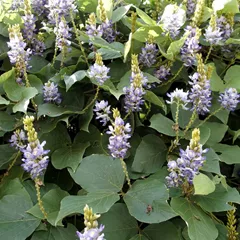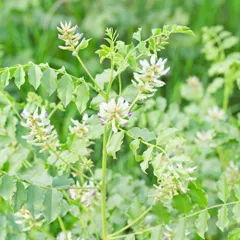Ge Gen Tang
Ge Gen Tang
Chinese: 葛根汤
Pinyin: Gé Gēn Tāng
Other names: Kudzu Decoction, Pueraria Combination,




Ge Gen Tang
Ge Gen Tang
Chinese: 葛根汤
Pinyin: Gé Gēn Tāng
Other names: Kudzu Decoction, Pueraria Combination,
Number of ingredients: 7 herbs
Formula category: Formulas that clear Wind-Cold
Conditions for which it may be prescribed: IritisSinusitisGingivitis and fifteen other conditions
- Releases the Exterior and muscle layer
- Forms Body Fluids
Source date: 220 AD
Source book: Discussion of Cold Damage
The information provided here is not a replacement for a doctor. You shouldn't use it for the purpose of self-diagnosing or self-medicating but rather so you can have a more informed discussion with a professional TCM practitioner.
Ge Gen Tang is a 7-ingredient Chinese Medicine formula with Kudzu Roots (Ge Gen) as a principal ingredient.
Invented in 220 AD, it belongs to the category of formulas that clear Wind-Cold. Its main actions are: 1) releases the Exterior and muscle layer and 2) forms Body Fluids.
In Chinese Medicine health conditions are thought to arise due to "disharmonies" in the body as a system. These disharmonies are called "patterns" and the very purpose of herbal formulas is to fight them in order to restore the body's harmony.
In this case Ge Gen Tang is used by TCM practitioners to fight patterns like Wind-Cold invading the Lungs or Wind invading the Channels joints and muscles. From a Western Medicine standpoint, such patterns can give rise to a range of conditions such as common cold, cervical spine disease or torticollis for instance.
On this page, after a detailed description of each of the seven ingredients in Ge Gen Tang, we review the patterns and conditions that Ge Gen Tang helps treat.
The seven ingredients in Ge Gen Tang

Ge Gen is a king ingredient in Ge Gen Tang. Like the name indicates, it means it has more power than other ingredients in the formula.
1. Kudzu Roots (Ge Gen)
Ge Gen releases the the Exterior and muscle layer, especially of the upper back and neck. It also directs Body Fluids to the affected areas.

Ma Huang is a deputy ingredient in Ge Gen Tang. This means it helps the king ingredient(s) treat the main pattern or it serves to treat a coexisting pattern.
2. Ephedra (Ma Huang)
In general Ma Huang's main actions are as follows: "Releases the surface through sweating. Promotes the circulation of Lung Qi and stop wheezing. Promotes urination."
In the context of Ge Gen Tang, it is used because it encourages sweating. It is very powerful in releasing excessive Cold from the Exterior.

Gui Zhi is a deputy ingredient in Ge Gen Tang. This means it helps the king ingredient(s) treat the main pattern or it serves to treat a coexisting pattern.
3. Cinnamon Twigs (Gui Zhi)
In general Gui Zhi's main actions are as follows: "Adjusts the nutritive Ying and defensive Wei Qi. Relieves the Exterior through sweating. Warms and disperses Cold. Removes obstruction of Yang. Promotes the circulation of Yang Qi in the chest. Regulates and moves blood."
In the context of Ge Gen Tang, it is used because it supports the chief herb Kudzu root in releasing the Exterior and muscle layer.

Bai Shao is an assistant ingredient in Ge Gen Tang. This means that it either serves to reinforces the effect of other ingredients or it moderates their toxicity.
4. White Peony Roots (Bai Shao)
Part used: Dried root
Nature: Neutral
Meridian affinity: LiverSpleen
Category: Tonic herbs for Blood Deficiency
Bai Shao prevents the Exterior releasing herbs from creating too much sweating so as to protect Yin. Together with Cinnamon twigs, it invigorates the Protective (Wei Qi) and Nutritive Qi (Rong Qi) and helps expelling any Pernicious Influences.

Sheng Jiang is an assistant ingredient in Ge Gen Tang. This means that it either serves to reinforces the effect of other ingredients or it moderates their toxicity.
5. Fresh Ginger (Sheng Jiang)
In general Sheng Jiang's main actions are as follows: "Relieves the Exterior and disperses Cold. Warms and circulates Qi in the Middle Burner. Calms a restless fetus and treats morning sickness. Treats seafood poisoning."
In the context of Ge Gen Tang, it is used because it regulates the Protective (Wei Qi) and Nutritive Qi (Rong Qi) and protects the Stomach from injury.

Da Zao is an assistant ingredient in Ge Gen Tang. This means that it either serves to reinforces the effect of other ingredients or it moderates their toxicity.
6. Jujube Dates (Da Zao)
Part used: Dried ripe fruit
Nature: Warm
Taste(s): Sweet
Meridian affinity: SpleenStomach
Category: Tonic herbs for Qi Deficiency
In general Da Zao's main actions are as follows: "Tonifies the Spleen and Stomach Qi. Tonifies the Blood. Calms the Shen (spirit). Moderates the actions of other herbs in formula."
In the context of Ge Gen Tang, it is used because it regulates the Protective (Wei Qi) and Nutritive Qi (Rong Qi) and protects the Stomach from injury.

Gan Cao is an envoy ingredient in Ge Gen Tang. This means that it directs the formula towards certain area of the body and/or harmonizes the actions of other ingredients.
7. Liquorice (Gan Cao)
Part used: Dried root and rhizome
Nature: Neutral
Taste(s): Sweet
Meridian affinity: HeartLungSpleenStomach
Category: Tonic herbs for Qi Deficiency
Gan Cao harmonizes the actions of the other herbs. Together with White peony root, it treats neck and back stiffness by relieving muscle spasms.
Conditions and patterns for which Ge Gen Tang may be prescribed
It's important to remember that herbal formulas are meant to treat patterns, not "diseases" as understood in Western Medicine. According to Chinese Medicine patterns, which are disruptions to the body as a system, are the underlying root cause for diseases and conditions.
As such Ge Gen Tang is used by TCM practitioners to treat two different patterns which we describe below.
But before we delve into these patterns here is an overview of the Western conditions they're commonly associated with:
Common cold Cervical spine disease Torticollis Periarthritis of the shoulder Lumbar disc Trigeminal neuralgia Cerebral vascular insufficiency Hypertension Cerebrovascular disease Otitis media Gingivitis Sinusitis Allergic rhinitis Tonsillitis Iritis Acute enteritis Bacillary dysentery Sinus Congestion
Again it wouldn't be correct to say "Ge Gen Tang treats common cold" for instance. Rather, Ge Gen Tang is used to treat patterns that are sometimes the root cause behind common cold.
Now let's look at the two patterns commonly treated with Ge Gen Tang.

The Lungs is a so-called "Zang" Organ. Learn more about the Lungs in Chinese Medicine
Wind-Cold invading the Lungs
Pulse type(s): Tight (Jin), Floating (Fu)
Tongue shape: Partially swollen
Symptoms: Fever Chills Sneezing Headaches Runny nose Body aches Itchy throat Blocked nose Aversion to cold Lack of sweating Shortness of breath White and watery sputum Coughing and wheezing with copious sputum
Ge Gen Tang is sometimes prescribed by TCM practitioners to treat Wind-Cold invading the Lungs. This pattern leads to symptoms such as aversion to cold, fever, itchy throat and shortness of breath. Patients with Wind-Cold invading the Lungs typically exhibit tight (Jin) or floating (Fu) pulses.
The Defensive Qi layer of the Lungs is invaded by the external Wind-Cold. The battel between these two takes place and gives rise to fever. This is similar to how the immune system reacts to the external bacterial or virus according to the Western Medicine. Please be aware that there aren't always... read more about Wind-Cold invading the Lungs

Wind is one of the pathogenic factors in Chinese Medicine. Learn more about Wind in Chinese Medicine
Wind invading the Channels joints and muscles
Pulse type(s): Floating (Fu)
Symptoms: Fever Joints pain Aversion to wind
Ge Gen Tang is sometimes prescribed by TCM practitioners to treat Wind invading the Channels joints and muscles. This pattern leads to symptoms such as joints pain, aversion to wind and fever. Patients with Wind invading the Channels joints and muscles typically exhibit floating (Fu) pulses.
It is a type of the Painful Obstruction Syndrome (Bi Syndrome 痹证). The Chinese name is called Xing Bi or Feng Bi (行痹 / 风痹).
This patter is similar to Cold invading the channels and joints. Both patterns evolve joints pain and stiffness, but the pain with Cold mostly occurs in one single joint,... read more about Wind invading the Channels joints and muscles
Formulas similar to Ge Gen Tang
Da Qing Long Tang is 71% similar to Ge Gen Tang
Gui Zhi Tang is 71% similar to Ge Gen Tang
Xiao Jian Zhong Tang is 57% similar to Ge Gen Tang
Dang Gui Si Ni Tang is 57% similar to Ge Gen Tang
Huang Qi Jian Zhong Tang is 57% similar to Ge Gen Tang
Huang Qi Gui Zhi Wu Wu Tang is 57% similar to Ge Gen Tang









